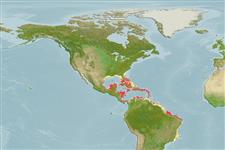Common names from other countries
>
Eupercaria/misc (Various families in series Eupercaria) >
Sciaenidae (Drums or croakers)
Etymology: Equetus: Latin, eques, -itis = horse, man in a horse, chevalier .
More on authors: Bloch & Schneider.
Environment: milieu / climate zone / depth range / distribution range
Ecologia
marino associati a barriera corallina; distribuzione batimetrica 3 - 30 m (Ref. 9710). Tropical; 36°N - 24°S, 98°W - 28°W
Western Atlantic: Bermuda, Florida (USA), and Bahamas to the Antilles (Ref. 26340) and Yucatan (Mexico) (Ref. 26938) to Brazil.
Size / Peso / Age
Maturity: Lm ? range ? - ? cm
Max length : 27.0 cm TL maschio/sesso non determinato; (Ref. 26340); common length : 18.0 cm TL maschio/sesso non determinato; (Ref. 5217)
Spine dorsali (totale) : 11 - 13; Raggi dorsali molli (totale) : 45 - 47; Spine anali: 2; Raggi anali molli: 6 - 8. First dorsal fin very high with short base. Second dorsal and caudal fins dark with white spots and dashes (Ref. 26938). Head white with two dark brown bars, one through eye, the other more posterior and more diagonal, extending across chest to pelvic fins; body white with a broad dark brown band beginning on front of first dorsal fin, curving across nape, above pectoral fin, and running to mid-base of caudal fin; two narrower dark stripes above and below this band (Ref. 13442). Mouth small, inferior, nearly horizontal. Spinous dorsal fin very elevated, higher than head length. Gas bladder simple, carrot-shaped without appendages. Sagitta (large earstone) near rounded and thick (Ref 51721).
Occurs primarily on coral reefs. Secretive and usually solitary, under ledges or near small caves (Ref. 7251). Often seen during the day around the bases of corals (Ref. 26938). Feeds at night on crabs, shrimps, and polychaetes. Easily approached (Ref. 9710). Has been reared in captivity (Ref. 35420).
Life cycle and mating behavior
Maturities | Riproduzione | Spawnings | Egg(s) | Fecundities | Larve
Robins, C.R. and G.C. Ray, 1986. A field guide to Atlantic coast fishes of North America. Houghton Mifflin Company, Boston, U.S.A. 354 p. (Ref. 7251)
IUCN Red List Status (Ref. 130435)
CITES (Ref. 128078)
Not Evaluated
Threat to humans
Reports of ciguatera poisoning (Ref. 30303)
Human uses
Pesca: scarso interesse commerciale; Acquario: Commerciale
Strumenti
Special reports
Download XML
Fonti Internet
Estimates based on models
Preferred temperature (Ref.
115969): 26.3 - 28.2, mean 27.4 (based on 675 cells).
Phylogenetic diversity index (Ref.
82804): PD
50 = 0.7500 [Uniqueness, from 0.5 = low to 2.0 = high].
Bayesian length-weight: a=0.00851 (0.00413 - 0.01752), b=3.08 (2.91 - 3.25), in cm Total Length, based on LWR estimates for this (Sub)family-body shape (Ref.
93245).
Trophic level (Ref.
69278): 3.5 ±0.3 se; based on diet studies.
Resilienza (Ref.
120179): Alto, tempo minimo di raddoppiamento della popolazione meno di 15 mesi (Preliminary K or Fecundity.).
Fishing Vulnerability (Ref.
59153): Low vulnerability (17 of 100).
